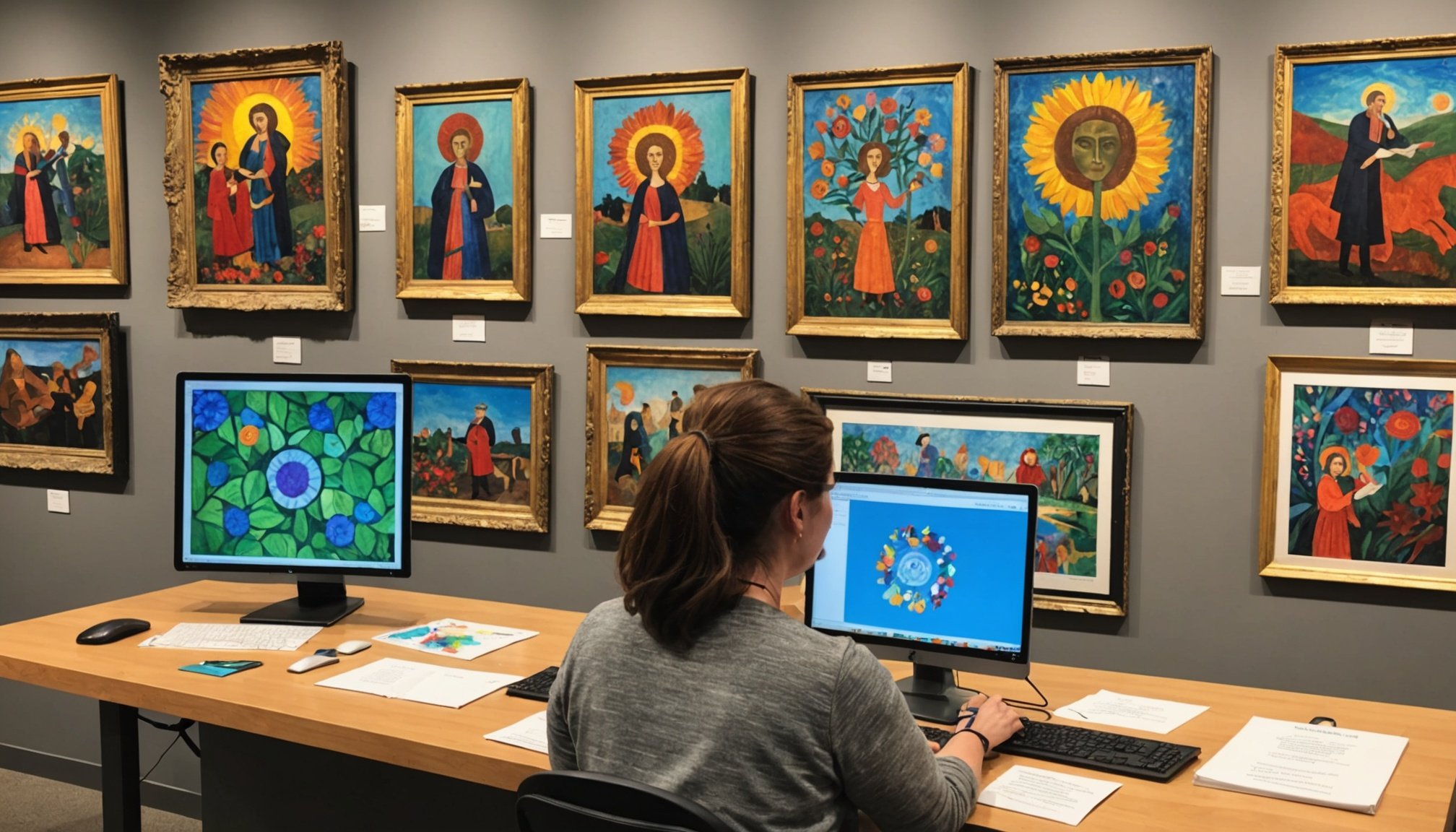Revolutionizing Art Engagement: Creative Therapeutic Programs in Museums for Visitors Battling Mental Health Issues
In recent years, the intersection of art and mental health has become a significant area of focus, with museums around the world pioneering innovative therapeutic programs to support individuals battling mental health issues. This article delves into the world of art therapy, muséothérapie, and other creative initiatives that are transforming the way we approach mental health care.
The Rise of Art Therapy in Museums
Art therapy, a well-established therapeutic approach, combines the creative process with therapeutic goals. This method allows participants to explore their emotions and express themselves through various artistic mediums such as painting, drawing, sculpture, music, or dance. The emphasis is not on the artistic quality of the work produced but on the creative process itself, which helps in releasing suppressed emotions and fostering a better understanding of oneself[1].
Additional reading : Transforming cities with vertical farming: an innovative approach to sustainable food production and reducing carbon emissions
Museums have begun to integrate art therapy into their programs, offering a unique setting for this therapeutic practice. For instance, the Musée des Beaux-Arts de Montréal, in collaboration with the Association des médecins francophones du Canada, launched the first “prescriptions muséales” in 2018. This initiative allowed thousands of patients to visit the museum as part of their treatment, highlighting the therapeutic benefits of engaging with art[2].
Muséothérapie: A New Age in Therapeutic Engagement
Muséothérapie, a concept that has gained momentum globally, particularly since the COVID-19 pandemic, involves the therapeutic use of museums and their collections. Unlike art therapy, which requires active participation in creating art, muséothérapie focuses on the contemplation and experience of art. This approach explores the effects of observing artworks, walking through exhibitions, and experiencing beauty, all of which can have profound therapeutic benefits.
In the same genre : Revitalize your well-being and the earth: discover the advantages of adopting a zero-waste lifestyle
Nathalie Bondil, a pioneer in this field, has advocated for the idea that “in the 21st century, culture will be for health what sports were in the 20th century.” Her work at the Musée des Beaux-Arts de Montréal and later at the Institut du monde arabe in Paris has been instrumental in establishing muséothérapie as a recognized therapeutic practice[2].
Benefits of Art Engagement on Mental Health
The benefits of engaging with art, whether through creation or contemplation, are multifaceted and well-documented.
Expression and Stress Reduction
Art therapy provides a non-verbal means of expressing emotions, which can be particularly beneficial for individuals who struggle with verbal communication. The creative process helps in accessing and expressing deep-seated emotions, leading to a reduction in stress and anxiety levels[1].
Boosting Self-Esteem
Encouraging personal expression through art can significantly enhance self-esteem. By creating something, individuals can develop a sense of pride and accomplishment, which is crucial for mental well-being[1].
Psychological Support
Art therapy is used to treat a range of mental health issues, including anxiety, depression, and trauma. The therapeutic environment provided by museums and art therapists helps individuals in processing their emotions and gaining a better understanding of themselves[1].
Cognitive Stimulation
Contemplating artworks can stimulate cognitive functions, improve mood, and reduce stress. Studies have shown that observing art activates specific areas of the brain, leading to cognitive benefits and improved mental health[1].
Global Initiatives and Examples
Several museums and institutions around the world are now offering innovative programs that combine art and therapy.
Canada: Pioneering Prescriptions Muséales
The Musée des Beaux-Arts de Montréal’s initiative has been replicated in other parts of the world. For example, Brussels launched its own “prescriptions muséales” in 2022, following the Canadian model. In France, projects like “Art sur ordonnance” in Montpellier and “Bulle d’Art” in Paris are integrating museum visits into healthcare treatments[2].
United States: Integrating Art into Healthcare
In the United States, institutions like the Museum of Modern Art (MoMA) have been at the forefront of art therapy. The “Meet Me” program at MoMA, designed for patients with Alzheimer’s, is a notable example of how museums can become spaces for therapeutic engagement[2].
Europe: Expanding Cultural and Therapeutic Horizons
In Europe, various museums are innovating in this space. The Louvre-Lens, for instance, offers free sessions where participants can engage in introspection with artworks. The Palais de Tokyo in Paris has introduced the “Hamo” space, focusing on cultural mediation and mental health support for neuroatypical audiences[2].
Practical Insights and Actionable Advice
For those interested in exploring these therapeutic programs, here are some practical insights and advice:
Finding the Right Program
- Research Local Initiatives: Look for museums and art therapy programs in your area that offer therapeutic sessions.
- Consult Healthcare Providers: Discuss your mental health needs with your healthcare provider to see if art therapy or muséothérapie could be beneficial.
- Engage in Community Activities: Participate in community art programs or join local art groups to experience the social and therapeutic benefits of art engagement.
Tips for Engaging with Art Therapeutically
- Start Small: Begin with simple creative activities like drawing or writing to express your emotions.
- Seek Professional Guidance: Work with an art therapist to understand how to use art as a therapeutic tool.
- Combine with Other Therapies: Integrate art therapy with other forms of therapy, such as cognitive-behavioral therapy, for comprehensive mental health support.
Table: Comparative Benefits of Art Therapy and Muséothérapie
| Aspect | Art Therapy | Muséothérapie |
|---|---|---|
| Participation | Active creation of art | Passive contemplation of art |
| Therapeutic Goals | Expression of emotions, stress reduction, self-esteem enhancement | Cognitive stimulation, mood improvement, stress reduction |
| Settings | Therapeutic studios, hospitals, educational institutions | Museums, galleries, cultural centers |
| Skills Required | No specific artistic talent needed | No talent required, focus on reception and experience |
| Benefits | Emotional expression, stress reduction, self-esteem enhancement | Cognitive stimulation, mood improvement, social integration |
| Examples | MoMA’s “Meet Me” program, hospital art therapy programs | Musée des Beaux-Arts de Montréal’s “prescriptions muséales,” Louvre-Lens’s “Louvre-Lens-Thérapie” |
Quotes from Experts
- “In the 21st century, culture will be for health what sports were in the 20th century.” – Nathalie Bondil, former director of the Musée des Beaux-Arts de Montréal[2].
- “The art therapy process helps in accessing and expressing deep-seated emotions, leading to a reduction in stress and anxiety levels.” – Dr. Gérald Kierzek, France Bleu[1].
The Future of Art and Mental Health
As research continues to support the therapeutic benefits of art engagement, museums and healthcare institutions are likely to further integrate these programs into their services. The use of digital technology, such as virtual reality, is also being explored to make these programs more accessible and engaging.
Digital Museums and Virtual Reality
The COVID-19 pandemic has accelerated the development of digital museum experiences. Virtual reality (VR) and augmented reality (AR) are being used to create immersive art experiences that can be accessed from anywhere. This technology holds promise for expanding the reach of art therapy and muséothérapie, especially for those with limited mobility or access to physical museums[2].
Community and Cultural Heritage
The integration of art therapy and muséothérapie into community programs is crucial for promoting mental health support. These initiatives not only provide therapeutic benefits but also help in preserving cultural heritage and fostering a sense of community. By engaging with art, individuals can connect with their cultural roots and find a sense of belonging, which is essential for mental well-being[3].
The revolution in art engagement for mental health is a testament to the power of creativity and culture in healing. As museums and healthcare institutions continue to innovate in this space, it is clear that art will play an increasingly important role in mental health care. Whether through active creation or passive contemplation, engaging with art offers a multitude of benefits that can transform lives.
By embracing these new therapeutic programs, we can create a world where art is not just a form of entertainment but a vital component of our mental health support system. As we move forward, it is essential to continue supporting research, community initiatives, and technological advancements that make these programs accessible to everyone. In doing so, we can ensure that the therapeutic benefits of art are available to all, fostering a healthier, more resilient community.











